
In the early study of hadrons, the following formula was used to relate electric charge to isospin.

Q = I3 + B/2
where Q is electric charge, B is baryon number, and I3 is the third component of isospin.
Later, a class of particles was detected in the high-energy regime typical of strong force interactions, but whose lifetimes were relatively long, typical of the weak force. This was considered strange behavior, and so they were called strange particles. In 1953, Murray Gell-Mann invented a new quantum number called strangeness.
The equation was then modified.

Q = I3 + (B + S)/2
where S is strangeness. This is called the Gell-Mann-Nishijima formula. Baryon number plus strangeness is called hypercharge.

Y = B + S
Q = I3 + Y/2
The spin states up and down gave their names to the isospin states up and down, which in turn gave their names to the up and down quarks. The proton is two up quarks and a down quark. The neutron is two down quarks and an up quark. Strangeness was also identified with a quark called the strange quark.
According to the Standard Model, there are three generations of particles, each containing two quarks, and two leptons, one of which is a neutrino. In the first generation, there is the up and down quarks, the electron, and electron neutrino. In the second generation, there is the strange and charm quarks, the muon, and the muon neutrino. In the third generation, there is the bottom and top quarks, the tau, and the tau neutrino. These are all fermions. In addition, there are the bosons that mediate the forces. The photon mediates electromagnetism. The eight gluons mediate the strong force. The W+, W-, and Z0 mediate the weak force. The Standard Model does not include gravitation, but gravity is mediated by the graviton. Also, according to the Higgs mechanism, which I describe later, there is a scalar particle left over called the Higgs particle.
Here are the fundamental particles.
| Name | Mass | Charge | Color | Spin | Baryon Number | Lepton Number | Year First Detected |
| up quark | 6 MeV | 2/3 | R, B, G | 1/2 | 1/3 | 0 | 1967 |
| down quark | 10 MeV | -1/3 | R, B, G | 1/2 | 1/3 | 0 | 1967 |
| strange quark | 0.25 GeV | -1/3 | R, B, G | 1/2 | 1/3 | 0 | 1967 |
| charm quark | 1.2 GeV | 2/3 | R, B, G | 1/2 | 1/3 | 0 | 1974 |
| bottom quark | 4.3 GeV | -1/3 | R, B, G | 1/2 | 1/3 | 0 | 1977 |
| top quark | 175.6 GeV | 2/3 | R, B, G | 1/2 | 1/3 | 0 | 1995 |
| electron | 0.511 MeV | -1 | none | 1/2 | 0 | 1 | 1897 |
| electron neutrino | 0.05 eV < m < 0.45 eV | 0 | none | 1/2 | 0 | 1 | 1953 |
| muon | 0.106 MeV | -1 | none | 1/2 | 0 | 1 | 1937 |
| muon neutrino | < 0.17 MeV | 0 | none | 1/2 | 0 | 1 | 1962 |
| tau | 1.777 GeV | -1 | none | 1/2 | 0 | 1 | 1975 |
| tau neutrino | < 24 MeV | 0 | none | 1/2 | 0 | 1 | 2000 |
| photon | 0 | 0 | none | 1 | 0 | 0 | wave - 1690 particle - 1905 |
| W+, W- | 80.3 GeV | +1, -1 | none | 1 | 0 | 0 | 1983 |
| Z0 | 91.2 GeV | 0 | none | 1 | 0 | 0 | 1983 |
| gluon | 0 | 0 |  , ,  , ,  , ,  , ,  , ,  , ,  , ,  |
1 | 0 | 0 | 1979 |
| graviton | 0 | 0 | none | 2 | 0 | 0 | not yet |
| Higgs particle | 125.3 ± 0.6 GeV | 0 | none | 0 | 0 | 0 | 2012 |
In the above list, the strange quark has a strangeness of -1, and all other particles have a strangeness of 0. Antiparticles have opposite signs for electric charge, baryon number, and lepton number, and have anticolors instead of colors. Colored particles only exist in combinations in which the colors cancel out. Baryons are three quarks. Antibaryons are three antiquarks. Mesons are quark-antiquark pairs. Glueballs are gluon-antigluon pairs. Baryons, antibaryons, and mesons are hadrons. A tetraquark is two quarks and two antiquarks. A pentaquark is four quarks and an antiquark.
For the photon, I have given the years that Christiaan Huygens proposed the wave model, and Albert Einstein proposed the particle model to explain the photoelectric effect, instead of year of first detection, since of course you are detecting photons with your eyes whenever you see. Newton had also believed that the photon was a particle. For the electron neutrino mass, I am using the results from the Karlsruhe Tritium Neutrino (KATRIN) experiment from April 2025. The discovery of the Higgs boson, the last particle of the Standard Model to be detected, was announced by the ATLAS and CMS collaborations at the Large Hadron Collider (LHC) at CERN on July 4, 2012. We will never be able to detect gravitons directly because they are so weakly interacting but gravitons are the quantization of gravitational waves in the same way that photons are the quantization of electromagnetic waves. While Einstein proposed the existence of gravitational waves in 1916, their direct detection wasn't achieved until 2015 by the Laser Interferometer Gravitational-Wave Observatory (LIGO).
Here are the relative strengths of the four forces.
strong - 10
electromagnetic - 10-2
weak - 10-5
gravity - 10-40
In the beginning of the 20th Century, atoms were imagined to have positive and negative charges spread uniformly throughout. Then in 1909, Ernest Rutherford's team fired alpha particles, which are helium nuclei, at aluminum foil, and some were bounced back, meaning that most of the mass of the atom was in a small dense core. In 1919, Rutherford proved that by bombarding air with alpha particles, a particle could be dislodged from the nitrogen nucleus. This particle appeared identical to the hydrogen ion. This suggested that atomic nuclei were made of these particles, which we now call protons. However, the proton has a positive charge, and a bunch of them are tightly packed in the nucleus. Electric repulsion should cause the nucleus to fly apart. Evidently, the electromagnetic force between them was compensated by a new mysterious force that attracted protons to each other. Since it was stronger than the electromagnetic force, it was called the strong force.
In 1935, Japanese physicist Hideki Yukawa predicted that there must exist some particle that mediated the strong force, analogous to the photon. The first hadron other than the nucleons to be discovered was the pion in 1947, and this was identified with Yukawa's strong force carrier. However, this was only the beginning, as a very large multitude of new particles were then discovered, first in cosmic rays, and then in accelerators. Independently, Murray Gell-Mann and George Zweig arranged these particles in patterns based on their properties, which could be explained by the idea that they were composed of smaller constituents. Gell-Mann named these hypothetical constituents "quarks" after a line in James Joyce's "Finnegan's Wake" that read "three quarks for Muster Mark". The constituent quark model was remarkably successful in predicting new particles, and explaining their characteristics.
Despite the phenomenological success of the constituent quark model, there was one obvious flaw in that no quark had ever been detected. Searches for the tell-tale fractional charge came up null. People even searched for quarks in mud and seawater. Many people were of the opinion that quarks were a useful computational tool but did not actually exist. Then in 1967, Jerome Friedman, Henry Kendall, and Richard Taylor at SLAC bombarded protons with electrons. In these inelastic collisions, they detected point-like constituents inside the proton, which were later identified with quarks. However, still no one had managed to observe a free quark outside a hadron. There was one baryon, the Δ++, which in the quark model was supposed to be composed of three up quarks, all spin up. They would all have to have the same quantum numbers which would violate the Pauli Exclusion Principle, which states that more than one fermion can't occupy the same state. Therefore, they invented a new quantum number which could be different for the three quarks, so they wouldn't all be the same. Later, this property was called color, and was used to explain why you never see free quarks.
The word "color" comes from color theory where red, blue, and green combine to form white. Here quarks only combine in combinations that are colorless.
baryon - red, blue, green
antibaryon - antired, antiblue, antigreen
meson - red-antired, or blue-antiblue, or green-antigreen
Quarks are red, blue, or green. Antiquarks are antired, antiblue, or antigreen. In some old books, they use the following terminology.
antired = cyan
antiblue = yellow
antigreen = magenta
Here are the wavefunctions of the baryon and meson.
Baryon-

[psi] =(1/[squareroot of 6]) [epsilon]ijkq1i q2j q3k
Meson-

[psi] = (1/[squareroot of 2]) q1iq2-i
Originally, Murray Gell-Mann and others put the up, down, and strange quarks in an SU(3) invariant theory.

However, this was only an approximate symmetry. Later, it was realized that the more fundamental SU(3) symmetry was an exact one based on colors.

where the strong force Lagrangian is

L = [summation]flavors [psi bar] (i[gamma]u Du + m) - (1/2)Tr FuvFuv
This is called quantum chromodynamics or QCD.
The covariant derivative is a 3 x 3 matrix.

Du = [partial derivative]u + igGu
where Gu is a combination of vector gauge fields called gluons and the generators Λi

Gu = (1/2)Gui/\i
The gauge invariant field tensor is given by

Fuv = [Du, Dv]/ig = [partial derivative]uGv - [partial derivative]vGu + ig[Gu, Gv]
The QCD Lagrangian can be written as

L = (g3/2) [summation]q = u, d [q bar][alpha] [gamma]u [lambda]a[alpha][beta] q[beta] Gua
where g3 is the strong force coupling constant, and Gua is the gluon field.
Now there is a big difference between QED and QCD. If you look at the Pauli matrices, they are diagonal but if you look at the λ Gell-Mann matrices, they are not all diagonal. Therefore, the photon does not possess electric charge but the gluons do possess color charge. This means that the color of a quark can be changed by exchanging a gluon.
Each gluon has a color and anticolor. This would give nine combinations. However, due to SU(3) symmetry, the colors combine to form the states that are actually realized. They are arranged into a octet and singlet analogous to what I'll show later for the up, down, strange SU(3) group. The SU(3) color octet forms the gluon colors which are as follows.

R[G bar], R[B bar], G[R bar], G[B bar], B[R bar], B[G bar], [squareroot of ½](R[R bar] - G[G bar]), [squareroot of 1/6](R[R bar] + G[G bar] - 2B[B bar])
The last two don't change the colors of the quarks that exchange them. The color singlet does not carry color, and can't mediate between color charges. Here is the SU(3) color singlet. It is associated with the meson state. It would be more accurate to say that this is the color of a meson since it is invariant under rotations in color space.

[squareroot of 1/3](R[R bar] + G[G bar] + B[B bar]
This color singlet state is also believed to refer to a particle called a pomeron, which is a colorless particle, whose exchange in an event is indicated by a rapidity gap, which is a region without particles. The virtual pomeron, which is presumed to be exchanged in diffractive processes, appears as a color singlet construct of quarks and gluons, perhaps a glueball.
Let's compare Feynman diagrams for electromagnetism and the strong force. On the left is two electrons exchanging a photon. On the right is two quarks exchanging a gluon.
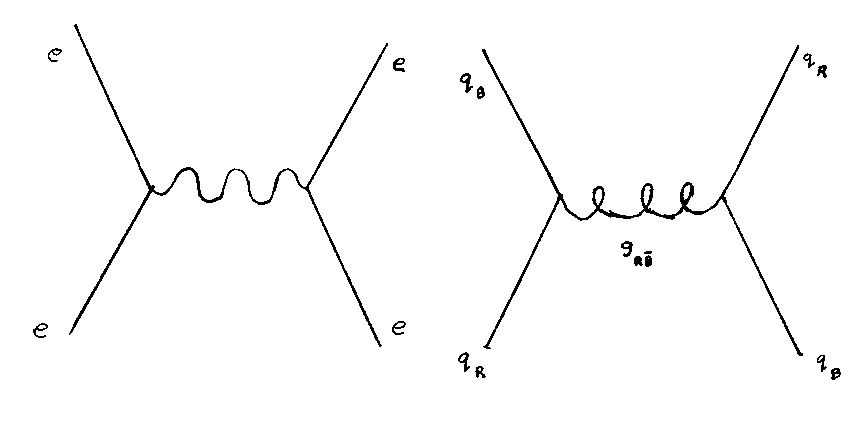
Now, the photon has no electric charge, and so the electrons might change momentum but their charges are not affected. The gluon, however, can carry color charge away from or to a quark. Here the gluon is red-antiblue. When a red quark emits a red-antiblue gluon, the quark changes from red to blue. When a blue quark absorbs a red-antiblue gluon, the blue quark turns red. You can draw the reaction like this.
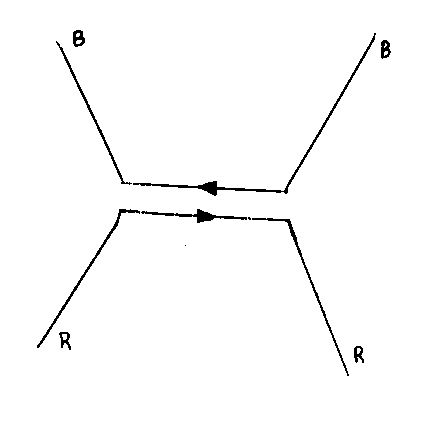
Here you can imagine the color traveling from one quark to another.
The fact gluons have color charge ultimately explains why you don't see free quarks. In order to explain why, I have to back up a bit. First, imagine the following metaphor. Let's say you have a dielectric material, and the molecules are electric dipoles. Initially, they are in a random orientation.
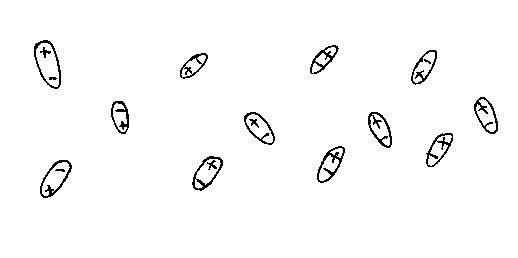
Then, let's say you place a negative test charge in the center. The molecules then all suddenly point to the center negative charge with their positive end pointing to the negative charge.
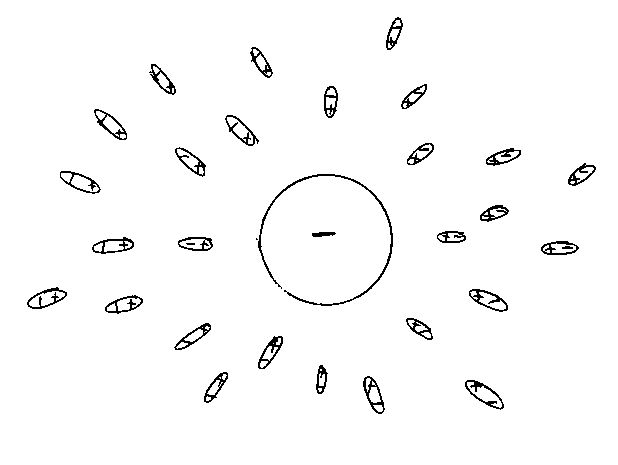
Now imagine a sphere surrounding this charge. There will be molecules that have one end sticking in the sphere, and the other end sticking out. The end sticking in the sphere will always be positive. Therefore, there will be slightly more positive charge than negative charge inside the sphere, not counting the center charge. The charge of the molecules inside the sphere will have a net positive charge. This positive charge will slightly off set the large negative charge in the center, so the total charge inside the sphere, including the center charge, will be slightly less negative than if there were no molecules. The larger the imaginary sphere, the more molecules will have their positive ends sticking in the sphere, and the more the center charge will be shielded. You could imagine a probe that measures charge located at the surface of the sphere. The measured charge of the center charge will increase as you get closer to the charge.
You have the same phenomenon if you try to measure the electric charge of an electron. In that case, it's not surrounded by molecules with an electric dipole, but electron-positron pairs. However, they act the same way. As you get closer to an electron, its measured charge increases. This is called charge screening. A low-energy probe in the long range limit measures a value of the coulomb charge called the fine structure constant.

[alpha] = e2/4[pi][h bar]c = 1/137
In the past, people thought this number was of profound fundamental significance. Some people have tried to get this number by combining all sorts of other constants together, and claim it's some sort of insight. Actually, this number is of no significance. The measured value of the coupling constant depends on the distance. The measured charge of an electron is higher closer to an electron. This has been confirmed experimentally. It is also believed that the coupling constants had different values in the early Universe, and originally all had the same value. This is called the running of the coupling constants.
A Landau pole in QED is a point at which the fine structure constant blows up as a function of the energy of the virtual photons being exchanged. In quantum field theory, the coupling constant for a particular force actually depends on an energy scale, which you can think of as the energy of the virtual particles being exchanged. For low-energy virtual photons, the fine structure constant is about 1/137, but at higher energies it gets bigger, and if there is a Landau pole, it actually becomes infinite. The existence of a Landau pole is usually taken as a sign that quantum electrodynamics breaks down when extrapolated to very high energies, which is the same as very short distance scales.
Now, you have the same phenomenon with quarks and color charge. A quark is surrounded by quark-antiquark pairs that shield its color charge. However, the gluons also have color, and they have the opposite effect. The gluons spread out the effective color of the quark. A red quark ends up being surrounded by other red charges, and so the measured red charge increases with distance. This is called antiscreening, and is the opposite of what happens with the electron.
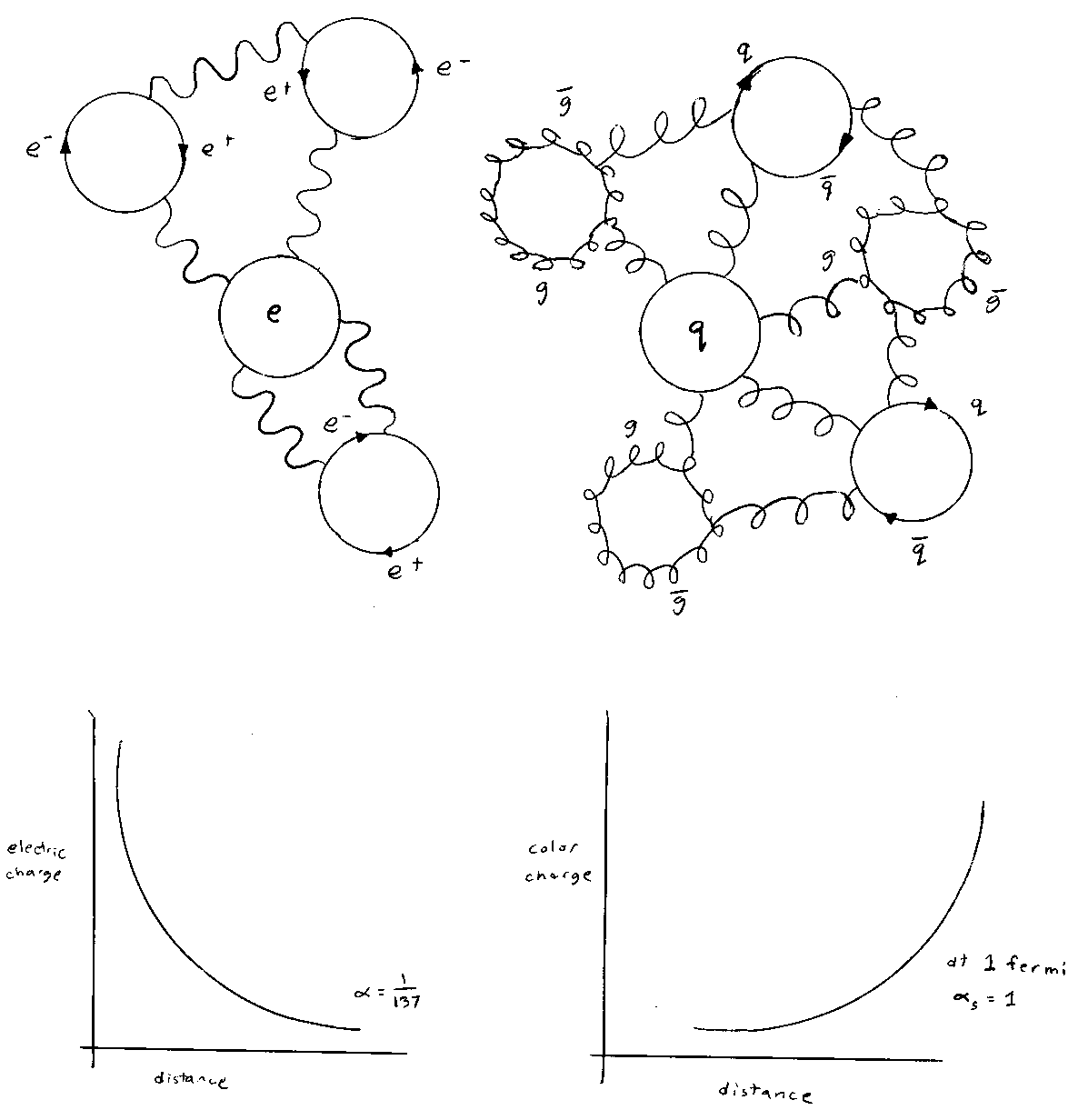
Because the effective charge of a quark increases with distance, this is why it's not possible to pull quarks apart. Here you can see the electric field lines of an electron, and the color field lines of a quark.
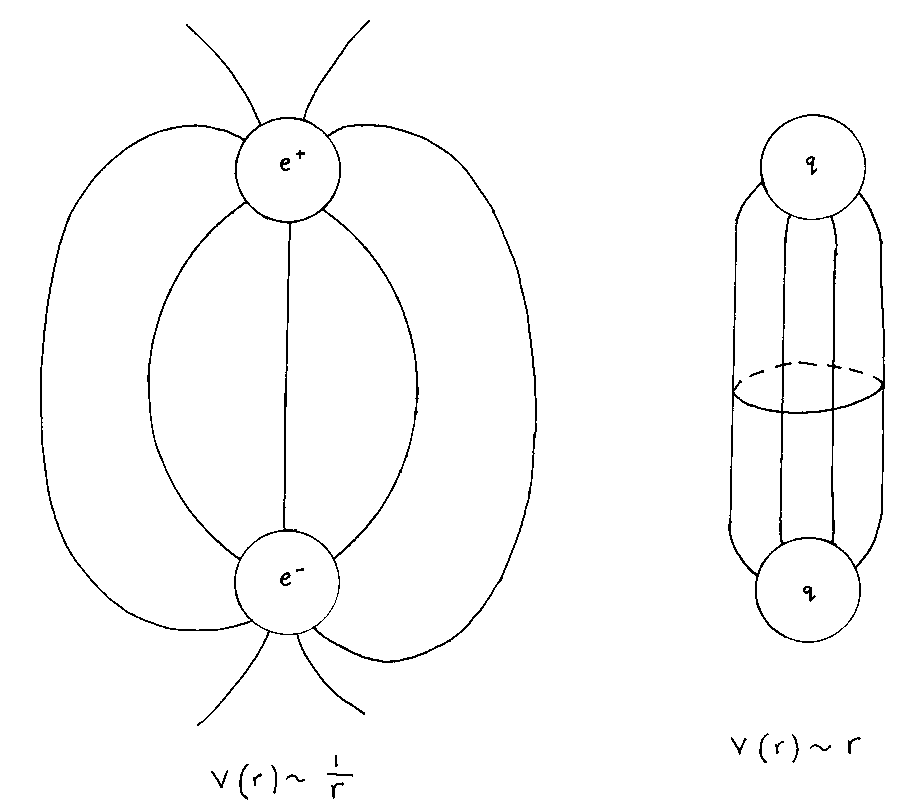
In the quark case, the field lines form a tube that increases in volume as the quarks are pulled apart. If you try to pull them apart, the energy bound up in this field becomes large enough to create other particles so it turns into other quarks, and so the quarks are never separated by much distance. If the distance between quarks increases, perhaps due to a collision in a particle accelerator, the force lines between them, which are sometimes called a color tube, increases in length until it breaks into smaller tubes with quarks at each end. This continues until the kinetic energy of the original quarks is converted into new quarks from which form the hadron jets seen in particle detectors at particle accelerators. Thus, you never see free quarks. This process is called confinement.
QCD and QED are very similar. The massless gluons exchanged between colored quarks are very similar to the massless photons exchanged between charged electrons. QCD has a more complex symmetry SU(3), rather than U(1). The main reason they act so different is simply that gluons are colored while photons are uncharged which causes the difference in the screening effects, and thus the measured magnitude of α and αs.
Due to these effects, it's very difficult to do calculations in QCD, especially at low energies. The equations are non-linear. Therefore we often resort to numerical computer simulations to get approximate results. The most successful method is called lattice QCD. Lattice QCD attempts to solve QCD problems by approximating spacetime with a discrete grid. Once they are put on a grid, these problems can be attacked by numerical methods on supercomputers. The approach was invented by Ken Wilson in 1974.
However, basically, quark-gluon interactions are computed with the rules of QED, using [squareroot of αs] instead of [squareroot of α] at each vertex. It's important to remember that QCD has been confirmed experimentally. In inelastic scattering experiments, analogous to Rutherford's experiments, constituent partons within the proton can be detected that have been identified with quarks. Not only that, but we have detected electrically neutral partons that can be identified with gluons. A proton is two up quarks and a down quark. These are called the valence quarks. In addition, there are all the quark-antiquark pairs which are called the sea quarks.
I'm not going to show all of the Feynman rules for all of the possible lines and vertices involving quarks and gluons. You can only use the Feynman rules for QCD at high energy. At low energy, which is the same as large distances, the quarks are very strongly interacting, and you end up with confinement. At high energies, or short distances, the quarks are very weakly interacting, and you can use the Feynman rules for QCD to calculate the scattering amplitudes. Therefore, QCD is called an asymptotically free theory. In 1973, David Politzer, David Gross, and Frank Wilczek determined that QCD had this property of asymptotic freedom, meaning that at high energies, the particles are weakly interacting. They received the 2004 Nobel Prize in physics for their work.
In developing the quark model, the baryons and mesons were placed in multiplets that were arranged as hexagons, giant inverted triangles, or even pyramids. These diagrams illustrated the patterns in their quantum numbers, such as charge, isospin, baryon number, and strangeness. I could show them all but it would be too much of a digression so I'll just give one simple example. The first studied hadrons, composed of up, down, and strange quarks, fit into octets of SU(3), and were therefore called "The Eight-Fold Way". Later, higher representations, such as decuplets, were found. Gaps in the diagrams predicted new mesons and baryons, specifically the Ω-, which consists of three strange quarks, similar to how gaps in the periodic table had predicted new elements. This shows the approximate SU(3) symmetry of up, down, and strange quarks in terms of how they combine to form mesons. It's a meson octet plus a singlet. The x-axis is the third component of isospin, I3, and the y-axis is hypercharge, B + S = Y. Also compare to the gluon colors which result from the exact color SU(3) symmetry.
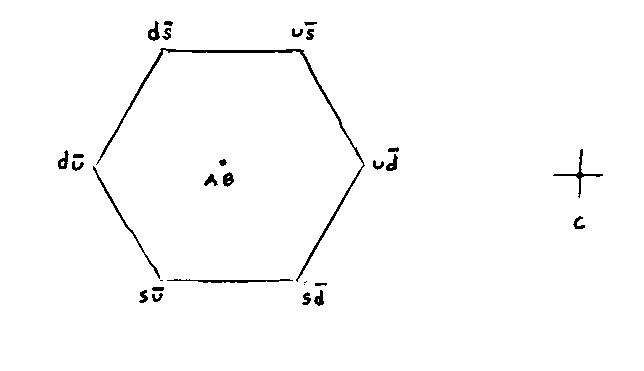
where
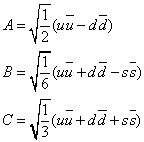
A = [squareroot of ½](u[u bar] - d[d bar])
B = [squareroot of 1/6](u[u bar] + d[d bar] + 2s[s bar])
C = [squareroot of 1/3](u[u bar] + d[d bar] + s[s bar])
Let's look at the following two gluons.
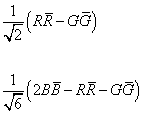
1/[squareroot of 2](R[R bar] - G[G bar])
1/[squareroot of 6](2B[B bar] - R[R bar] - G[G bar])
There is a 2-dimensional complex space of these gluons. The above two gluon states are orthogonal to each other, and are of unit size in this space. The colors and anticolors can be arranged in a hexagonal grid such that three directions correspond to colors, and the other three to anticolors. The gluon

1/[squareroot of 2](R[R bar] - G[G bar])
causes R and R quarks to repel, G and G to repel, and R and G to attract. The gluon

1/[squareroot of ](2B[B bar] - R[R bar] - G[G bar])
causes B and B to repel, R and R to repel, G and G to repel, B and R to attract, B and G to attract, and R and G to attract. Therefore, like charges repel and opposite charges attract. So if you had a red quark by itself, it would repel another red quark, and attract a blue and green quark, and form a baryon. The attractions and repulsions are a quantum interference effect between processes in which no gluons are exchanged, and those where a gluon is exchanged. If the gluon process has a minus sign in it, it attracts, otherwise, it repels.
In quantum mechanics, the probability that a particle is in a particular state is determined by squaring the absolute value of the amplitude for it to be in each of the possible states, and then adding up all the values. For the following gluon

1/[squareroot of 6](2B[B bar] - R[R bar] - G[G bar])
there is amplitude of

2/[squareroot of 6]
for it to be in a B[B bar] state, an amplitude of

1/[squareroot of 6]
for it to be in the G[G bar] or R[R bar] states. When you add them together, you get a probability of 1.
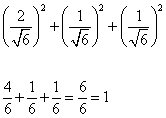
(1/[squareroot of 6])2 + (1/[squareroot of 6])2 + (1/[squareroot of 6])2
4/6 + 1/6 + 1/6 = 6/6 = 1
If the probabilities add up to 1, it's called normalized, which is what you want. That's why you include the 1/[squareroot of 2] and 1/[squareroot of 6] factors.
There are also the six other gluons that change the colors, and they can also attract and repel, due to quantum interference between processes where no gluons are exchanged, and processes where a gluon is exchanged. If the quarks are in the state

1/[squareroot of 2](RG - GR)
they will attract. If they are in the state

1/[squareroot of 2](RG + GR)
they will repel. In quantum mechanics, you can take quantum superpositions not only of single particle states, but all possible states. This is called entanglement. A quark in the 1/[squareroot of 2](RG - GR) is the same as an antiblue quark.
The six gluons can't be distinguished from the other two gluons because the SU(3) symmetry mixes them with each other. For instance, one of the symmetries of SU(3) is that it is the same if you replace R with 1/[squareroot of 2](R + G), and replace G with 1/[squareroot of 2](G - R). The SU(3) has eight dimensions, same as the number of gluons, and thus there are many different ways to mix the different colors of quarks. If you take the following gluon

1/[squareroot of 2](R[R bar] - G[G bar])
and the result of the transform is

½[squareroot of 2](R + G)([R bar] - [G bar]) - ½[squareroot of 2](G - R)([G bar] - [R bar])
which is the same as

1/[squareroot of 2](R[G bar] + G[R bar])
so therefore the two gluons can be thought of as a superposition of the other six gluons. There is no distinction between the six gluons that change the colors of quarks, and the two other gluons, because they are mixed together by the SU(3) transform. They are all within the 8-dimensional representation of SU(3). The two gluons don’t interact with each other because they have the same colors as anticolors, but they do interact with the other six gluons, and thus do have color charge.
In electromagnetism, if the charges balance out in positives and negatives, the result is neutral, but that’s not true for the strong force. A particle is only neutral in a force if it is unaffected by the symmetry the force is based on. Therefore, a red-antired meson is not color neutral because the symmetry saying R and G are the same mixes it with, say, the green-antigreen meson. The only color neutral meson combination is

1/[squareroot of 3](R[R bar] + G[G bar] + B[B bar])
The only color neutral baryon combination is

1/[squareroot of 6](RGB - RBG + GBR - GRB + BRG - BGR)
If a particle is composed of constituent particles, the constituent particles can exchange bosons that cause them to turn into other particles. As a result, the overall particle they had previously comprised will decay into other particles. The strength of the force involved has a great effect on the time it takes the overall particle to decay. Here is a typical decay via the strong force.

[delta] -> p[pi]
which has a lifetime of 10-23 seconds. There are also decays via electromagnetic interaction such as

[sigma] -> [lambda][gamma]
which have decays in the 10-20 - 10-16 seconds range. This is what you would expect if

[alpha] ~ .01[alpha]s
[tau]e/[tau]s = ([alpha]s/[alpha])2 = 104 - 106
However, this does not explain much longer lifetimes. There are some particles that have a lifetime of 10-12 seconds or more. An example is

[pi]- -> e + [nu bar]
which has a lifetime of 10-12 seconds. However, the most extreme example is the decay of the neutron.

n -> p + e + [nu]
This is called beta decay. The neutron has a lifetime of 15 minutes! Obviously, this can't be explained by either electromagnetism or the strong force. It has to be a new force. This new force is weaker than the strong force or electromagnetism, so it was called the weak force.
Based on the difference in the lifetimes, the coupling constant for the weak force would be

[alpha]w = 10-6 [alpha]s
Unlike the strong force, the weak force acts on both leptons and quarks. Also, the weak force can change a down quark into an up quark, or a muon into a neutrino. The weak interactions change the quark and lepton flavor.
In 1934, Enrico Fermi thought up a Lagrangian for the weak interaction. The fermion current is

Ju = [psi bar] [gamma]u [psi]
The Lagrangian has to be a product of four fermion fields.

[psi bar]p [psi]n [psi bar]e [psi][nu]
If these contain creation and annihilation operators, the lowest order processes then describe beta decay. Fermi came up with the following Hamiltonian.

H = (GF/[squareroot of 2) [psi bar]1 O [psi]2 [psi bar]3 O [psi]4
where GF is the Fermi constant. When Fermi originally wrote this, he defined O to be consistent with Lorentz invariance and parity symmetry. Then, in 1956, in order to explain τ - θ, Lee and Yang suggested that weak interactions do not conserve parity. In 1957, this was experimentally confirmed by Wu, Amber, Hayword, and Hobson in the decay of polarized Co60. Then in 1957, Marshak, Sudarshan, Feynman, Gell-Mann, and Sakurai suggested the following form

O = [gamma]u (1 + [gamma]5)
This gives an axial vector. Therefore, the interaction is called vector - axial vector, or V - A. The Fermi Lagrangian then takes the following form.

L = -(GF/[squareroot of 2]) [[psi bar]p [gamma]u (1 - g[gamma]5) [psi]n] [[psi bar]e [gamma]u (1 - [gamma]5) [psi][nu]]
Since he derived this for protons and neutrons, which we now know are not fundamental, g = 1.26. For quarks, g = 1. GF is the Fermi constant.

GF/([h bar]c)3 = 1.166 x 10-5 GeV-2
The Fermi Lagrangian contains γ5 which violates parity. Therefore, the Fermi Lagrangian is only capable of creating neutrinos with left-handed helicity. This does not mean that right-handed neutrinos are impossible, only that they are created in tiny amounts since the neutrino's mass is so small.
Fermi's theory is not renormalizable. The diagram for muon decay would be
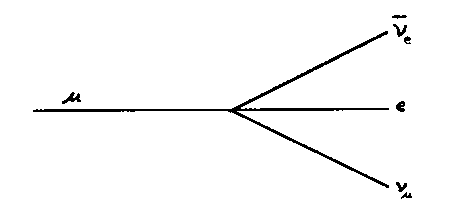
We know this can't be right since there is no boson mediating the force. He essentially imagined that the boson had infinite mass so it's range was zero, and thus didn't exist. In this version, the coupling constant is in units of [energy]-2 instead of dimensionless.
In order to get a renormalizable theory, you should instead use
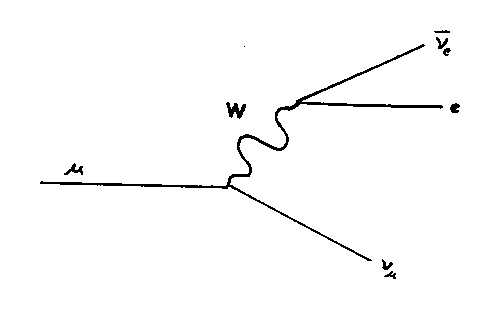
Even then, it's only renormalizable if mW = 0. However, if that were true, it would be of infinite range, which it is not. Later, this was explained using the Higgs mechanism.
The weak interaction is described by an SU(2) symmetry. Particles can be grouped into doublets of particles that differ by one unit of charge.

Therefore, the emission or absorption of a particle with a charge of +1 or -1 can cause a particle to change into the other particle in its doublet. These particles with charge of +1 and -1 are called the intermediate vector bosons, and are symbolized by W+ and W-.
The symmetry suggests the following transformation.

[psi] -> ei[theta]M
where M is a 2 x 2 matrix. The generators must be Hermitian and traceless, corresponding to SU(2), and therefore must be the Pauli spin matrices. If the weak force Lagrangian is invariant under SU(2) transformations, the group element

g = 10[theta]iGi
shows that each of the three generators Gi is associated with an arbitrary angle θi. Remember before, we added a field identified with the photon to make it locally invariant. Here, it's the same, except you have to hide three angles. Therefore, you have to add not one or two but three gauge fields to hide these angles. That means there must exist a third intermediate vector boson in addition to the two we already know about. This is the Z0 intermediate vector boson which is electrically neutral.
You might expect the following transformation to ensure gauge invariance.

Wuj -> Wuj - ([partial derivative]u[theta]j)/g
However, this will not work because the group is non-Abelian. You must therefore have the following transformation.

Wuj -> Wuj - (1/g)[partial derivative]u[theta]j + fjklWuk[theta]l
where fjkl are the structure constants. For SU(2), the generators are Pauli spin matrices, and the structure constants are εijk.
This transformation law for non-Abelian gauge fields causes the kinetic part of the Lagrangian to take the following form.

Lkinetic = -(1/4) Fiuv Fiuv
where

Fiuv = [partial derivative]uWvj - [partial derivative]v Wuj - g fjkl WukWkl
This means that the gauge bosons can self-interact.

You can think of the fields and particles as being created by other fields combining in a certain way. For instance, the photon is considered to be a fundamental particle but the electromagnetic field Au can be considered to be the result of two other fields, Wu and Bu. This is not to say that photons or the electromagnetic field are made of something else, but that mathematically, it can be described that way.
The boson fields of the weak force are Wiu, where i = 1, 2, 3 and they combine in the following ways to form the following particles.
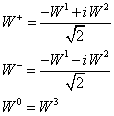
W+ = (-W1 + iW2)/[squareroot of 2]
W- = (-W1 - W2)/[squareroot of 2]
W0 = W3
There is no particle called W0 but later this field will combine with the Bu field to create the electromagnetic field Au and the Z0. Compare with the pion isospin states I gave earlier. Before that, however, I want to write down the Standard Model Langrangian.